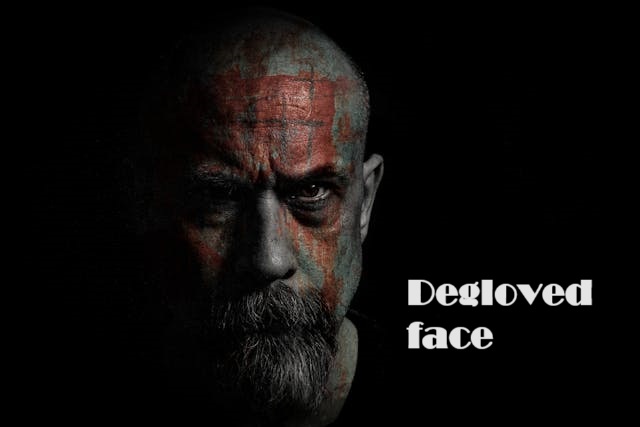
Degloved Face | A Comprehensive Guide About This Severe Injury
In this world, many types of small, severe, injuries happen because of so many issues like traffic accidents, farm equipment mishaps, falls from heights, sports injuries, animal collisions, fire accidents and many more. But most of the accidents end with one severe injury – a degloved face also called avulsion. Which is the most painful and most terrifying injury a patient can face.
A degloved face happens when there is severe trauma, like a vehicle accident, that tears off a significant portion of skin and the layer of soft tissue underneath. Facial degloving is often included in facial plastic surgery procedures. Most of the time, patients will be dead because of major injuries and blood loss.
In this article, we are going to discuss with you the causes of degloving injuries, types and symptoms, complications, diagnosis, treatment, patient care tips, and more.
Degloving: What Is It?
A Degloved face, also known as an avulsion, occurs when a large section of your skin and the underlying soft tissue layer that is normally attached to your face is partially or fully pulled away from your face. A face can change the whole body’s structure when it transforms from beautiful to horrible. It is also the most painful and irritating situation for those who facing the problem of this crisis. This injury can occur anywhere in your body especially face, scalp, chest, limbs, and genitalia. In most cases, patients who struggle with this injury die from massive blood loss.
There are two major types of degloving injuries, open and close. Let’s read what is the definition of open degloving and close degloving injury.
Degloving Face: Different Types Of Injuries And Symptoms
Accidents happen, and unfortunately, some can result in severe facial injuries. One such category is degloving face injuries, which can have a deep impact on an individual’s life.
There are two main types of degloving injury occur – open and closed. Let’s explain it thoroughly –
Open Degloving (External):
Open degloving is one of the most serious and painful injuries that arise. Some facts about this wound;
- Open degloving face injury is visual. It happens when a part of your skin is completely pulled away and sometimes underneath bones are observable. It may seem that the skin is completely drawn from the body or may be hanging on the exact area of injury.
- Usually, the main causes of open degloving wounds are; car, bike or bicycle accidents, construction injuries, farm equipment mishaps, falls from a high spot, sports injuries, animal collisions, etc.
- Open degloving injuries most happened on; the face, legs, trunk, scalp, abdomen.
Closed Degloving (Internal):
- Because they are less noticeable than open degloving, closed or internal degloving injuries are more challenging to detect. It typically occurs when the skin separates from the deeper layers of connective tissue and muscle. Sometimes, closed degloving wounds are referred to as Morel-Lavalley wounds.
- Closed degloving wounds happen in the exact types of accidents as open degloved.
- Closed degloving mostly seems to trochanter, torso, buttocks, lower back, shoulder blades, knees, pelvis, thighs.
Symptoms Of Degloving Injuries:
Where an injury occurs, symptoms are definitely included. Both open and closed degloving injuries can cause pain, but the harshness of the pain will depend on the period of the degloving injury. Here, Degloved face injury contains different symptoms including;
Typical Symptoms Of Open Degloving Injuries Include:
- excruciating agony
- severe cuts
- exposed connective tissue, bone, muscle, tendons, and/or nerves
- severe loss of blood
- Complete or partial separation of the skin
- Shock of tissue death
Symptoms Of Closed Degloving Injuries Include:
- Anguish
- Injuries and discolouration of the skin
- Swelling Sensitivity
- Skin that is dry and cracked
Causes Behind Degloving Injuries
Accidents are the main cause of Degloved face injuries. There are many causes of this kind of injury but most of the time, the main causes of degloving injuries are – car, bike or bicycle accidents, construction injuries, farm equipment mishaps, falls from a high spot, sports injuries, animal attacks or sometimes rings getting pulled from fingers.
Suppose a woman was riding a bike and her long hair got caught on a conveyor belt. Conveyor belts have the power to rip the skin and soft tissues forcefully apart from the muscles and tissues of the head. This is enough example to understand how an injury can become a painful death.
Degloved Injuries: Complications
Depending on the harshness of your traumatic injury, you may guess how long you may survive. It can take a while for you to recover. It must need physical therapy, rehabilitation, and ongoing medical supervision. The injured body part may no longer work as before. It contains a serious risk of infection. The following complications may occur if there is a severe case of degloving:
- Red marks edges surrounding the injured area
- Swelling,
- Drying,
- Cracking,
- Bleeding,
- Deep bruising,
- Itching,
- Nerve damage,
- Contracture (Muscle shortening),
- Bone infection,
- Death.
Diagnosed Degloving Injuries
Typically, open degloving injuries are diagnosed in an ER or trauma center. To confirm whether you have been injured, your healthcare practitioner may perform a physical examination of your bruises and bleeding, as well as look at the colour, warmth, and reaction of your skin.
Victims of internal (closed) degloving injuries may experience endless pain, swelling, and bruising at the injured area over time. But external degloving is often done using imaging techniques that include; Ultrasonography, computed tomography and magnetic resonance imaging.
Treatment Of Degloving Injuries
Treatment options are many due to the variety of degloving injuries that can occur. The severity of your wound will determine what your doctor decides. Preserving as much of your skin as possible should come first. Skin flaps can treat less severe injuries, but if your injury is major and harmful to the body, reconstructive surgery or even amputation may be required.
Degloved face injuries require a long healing procedure that may take several stages. Support from both a physical and emotional standpoint is essential in assisting people in recovering from their injuries. There are some treatment methods for degloving injuries;
Options for treating degloving injuries:
- The degloved skin being reattached
- Reattaching the toes or fingers
- Amputation
- Bandages for compression
- Physical intervention
- Fluid in the wound draining
- Dead tissue removal and injections to help swollen blood vessels contract
- Wound VAC (vacuum-assisted wound closure), uses a device to lessen pressure on the wound.
- Necrotic tissue preparation for surgery, which may involve fluid drainage, excision, or debridement
- Revascularization is a process that helps the affected area’s blood flow return.
- Skin grafts, sometimes known as flaps, replace lost skin from degloving with skin from another area of your body.
Contact Your Healthcare Provider For Emergency
Degloving is a potentially deadly medical emergency. If you or someone has suffered a traumatic injury, get medical help right once by calling 911 or visiting the hospital. It’s crucial to keep an eye on the damages if any symptoms may occur, like:
- Palpitations in the heart
- Dizziness
- Bewilderment Passing Out
- Sweating excessively
- Feeble heartbeat
- Low blood pressure
- Absence of urination
- Clammy limbs
- Excessive breathing
- Skin discolouration.
Conclusion:
Severe accidents change our all-day routine, it will be painful, and heartwarming. By addressing the causes, symptoms, and treatment options, we covered some important information about Degloved face injuries as much as possible. Hope you may understand our tips step-by-step. Stay careful, stay well.
FAQs:
Q: What Is A Degloving Face Injury?
A Degloved face, also known as an avulsion, occurs when a large section of your skin and the underlying soft tissue layer that is normally attached to your face is partially or fully pulled away from your face. This injury can occur anywhere in your body especially face, scalp, chest, limbs, and genitalia.
Q: What Are The Types Of Degloving Injuries?
There are two main types of degloving injury, including – open and closed degloving injury.
Q: How common are degloving face injuries?
While not as common as some other injuries, degloving face injuries can occur, especially in accidents involving significant force.
Q: What Are The Main Causes Of Degloving Injuries?
Usually, the main causes of degloving injuries are; car, bike or bicycle accidents, construction injuries, farm equipment mishaps, falls from a high spot, sports injuries, animal attacks, etc.
Q: What Is The Definition Of Open Degloving Injury?
Open Degloved face injury usually happens when a part of your skin is completely pulled away and sometimes underneath bones are observable by a severe accident. It may seem that the skin is completely drawn from the body or may be hanging on the exact area of injury.
Q: What Is Closed Degloving Injury?
Closed or internal degloving injuries (Morel-Lavalley injuries) typically occur when the skin separates from the deeper layers of connective tissue and muscle. It is the kinds of wounds that are more challenging to detect.
Q: Is surgery always required for degloving face injuries?
Surgical intervention is often necessary to address the extensive damage caused by degloving injuries, but the specific approach depends on the harshness of the wounds.
Q: Can degloving face injuries have long-term psychological effects?
Yes, the psychological impact of such injuries can be long-lasting, requiring attention and support.



